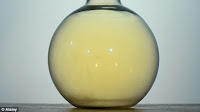ACKNOWLEDGEMENT:
Figure (respectively)
|
Source of Figure
|
Figure 1
|
http://fashions-cloud.com/
|
Figure 2
|
http://www.dailymail.co.uk/
|
Figure 3
|
http://pixshark.com/
|
Figure 4
|
http://dir.indiamart.com/
|
Figure 5
|
http://heathen-hub.com/
|
Figure 6
|
ttp://www.dkfindout.com/
|
Group VII: Halogens
- Group VII elements called Halogens (salt makers) consists of 7 electrons in their valence shell.
- They form a family of non-metallic elements that exists as diatomic molecules.
- Boiling point increases down the group.
- Reactivity of Halogens decreases down the group.
- This is because, as the atomic number increases, the radius of the atom increases, pushing the valence shell and hence the valence electrons further away from the nucleus. The valence shell is loosely attached to the atom by a weak electrostatic force from the nucleus. Therefore, it is hard for the atom to gain an electron. Hence, reactivity of Group VII elements decreases down the Group.
- They form -1 negative ions by gaining an electron. (usually from metals). This ion is called halide.
- They react with metals to form salts.
- They undergo displacement reactions, where a less reactive halide is displaced by a more reactive halide in its salt solution.
- This displaced bromine changes the colour of the solution to brown.
- In diatomic state, they form coloured compounds.
Table 2:
Fluorine
|
Yellow coloured gas
| |
Chlorine
|
Light Green coloured gas
| |
Bromine
|
Reddish brown gas
| |
Iodine
|
Black solid
|
Magenta/Purple vapours
|









